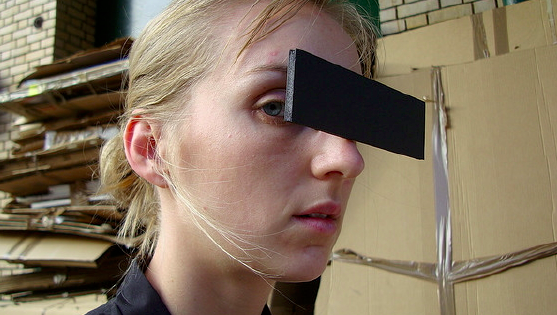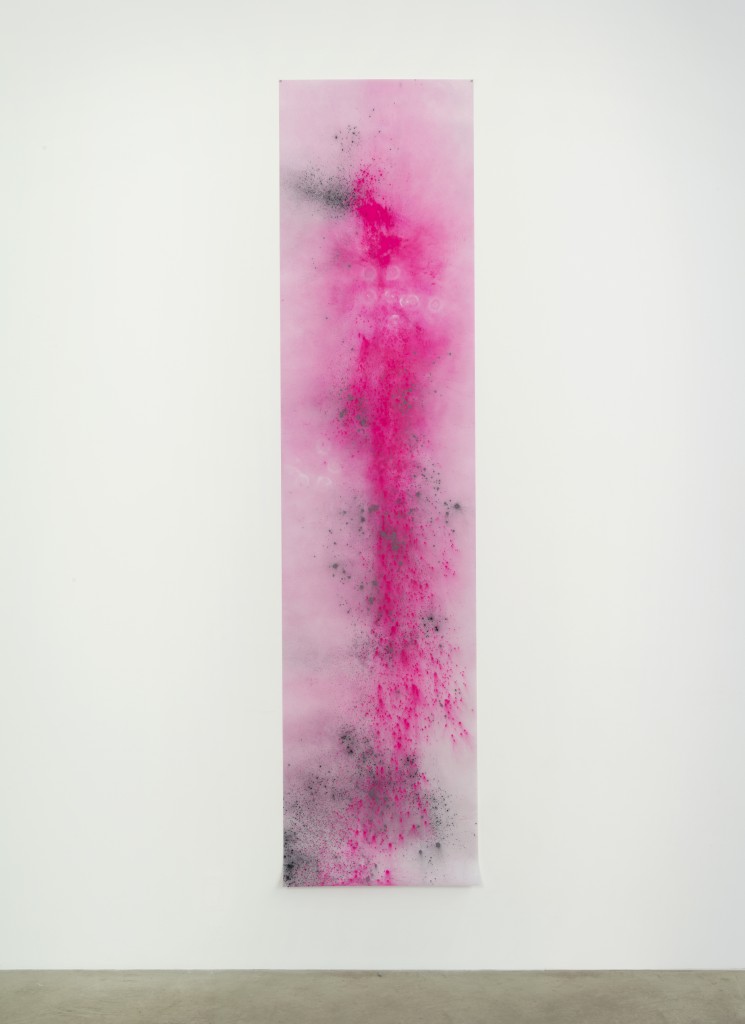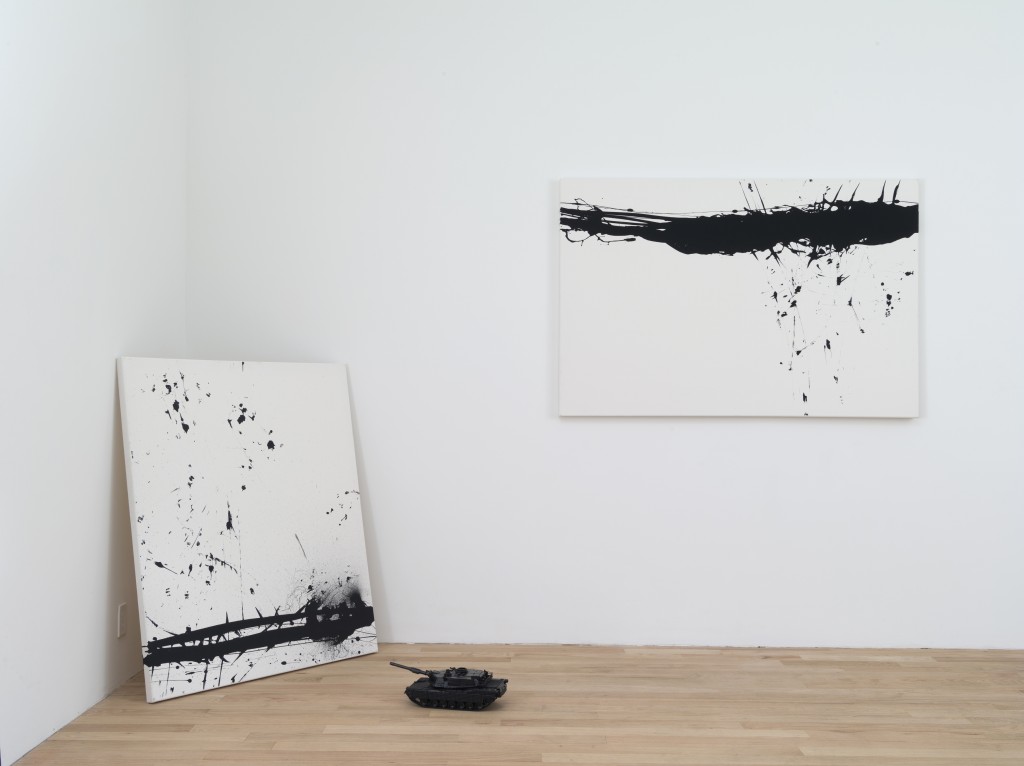A conversation with Addie Wagenknecht

In 2007, Addie Wagenknecht had the idea of using drones as a paintbrush. The resulting works—which manage to be both abstract and orderly, playful and sinister—hold a firm place in the drone art canon. If artists ever begin to replace their studio assistants with quadcopters, we will thank (or blame) Wagenknecht. Her colorful, intricate work turns a sharp eye on surveillance, networks, and artificial intelligence. Addie’s first solo show in the U.S., Shellshock, which includes several drone paintings, is currently on on view at bitforms gallery in NYC.
Addie Wagenknecht is based in Vienna, Austria. She is a member of Free Art & Technology (F.A.T.) Lab, Taco Bell Drawing Club and is the Chair of the Open Hardware Summit at MIT. She serves on the board of the Open Hardware Association.
This is what drone painting looks like:
[vimeo 111941915 w=500 h=281]
Interview by Arthur Holland Michel
Center for the Study of the Drone It’s November 4th. We’re at bitforms, on Allen St. What exactly do you do with drones? How do you make the paintings?
Addie Wagenknecht I work with a horizontal surface. I have a Parrot drone, which I use as a kind of crop duster to apply the initial pigment. I have the smaller drones from a Chinese hobby store, which I use for more detailed work: to play with turbulence, air currents and flips. They are generally less consistent in their dynamics and usability, so, for instance, if they flip they create patterns using the propellers. They become a mechanism for distribution of the pigment, so it’s really this relationship between the materials and the drone. The body of the creator is absent.

Black Hawk Powder
Photo by John Berens
Photo courtesy bitforms gallery, New York
Drone The colors are tremendous.
Wagenknecht One of the first times I went to India, in the early 2000s, I was there over the Holi festival, so it was a place full of bright, colored powder in the air, and that inspired me—that is, this theme of the colors, textures of air, the vibrancy of it all. So for some of the works, I’m using a natural beet dye which I sourced from India; it’s a rich deep hot pink. The blacks are gunpowder. And I started recently also using photochromic pigments and thermochromic pigments that react within a certain temperature range, and it’s a certain gradient, so you can go from clear to black, or from pink to blue, kind of like the hyper-color t-shirts from the 80s, early 90s. It’s extremely reactive to the light. So if you put it near a window, there would be an instant reaction once the sun hit it, and it creates very sharp colors, where the light will hit it or not hit it, so you’ll get these Rothko-esque square colors.
Drone Do the drones have any autonomous capability, or are you controlling them?
Wagenknecht The earlier works—I started doing them 2007, 2008 when I was a fellow at Eyebeam—I was using computer vision with the drones, so there was both a vertical and horizontal plane to control them based on software I was writing. It was a much more highly controlled process; I wanted to see how absent a person could be to the creation of something unique. The pieces I’m working on now have evolved into a more playful process, where I’m creating works that are interactive without utilizing traditional methods of computers and networks. I wanted to make pieces that did not rely on these traditional notions of interactivity, so as a result, they respond to temperature and UV rays within the space. They are always different depending on the time of day, seasons, or placement within a space.
Drone What are some of the difficulties of painting with drones? What are the challenges?
“It’s very similar to traditional methods of painting. And yet…”
Wagenknecht You form a relationship with it, like you do with all materials. It’s not that much different from using a traditional brush, really. You learn the process of how to use it, and you train yourself to use it, and then you evolve that process as you become more familiar and more fluent. It’s really just a new tool. I think that other people who have started painting with drones, we all have very different aesthetics and approaches. So again, it’s very similar to traditional methods of painting. And yet…
Drone ..also different. Can you control the process with a drone like you could with a brush? Or do you leave something up to the machine?
Wagenknecht It depends on how you view the machine. I think that you lose some control in both approaches. There’s lots of human error. And so if you understand the tools and you have a comprehension of how they work, and they’re not closed versus open, or if they are closed you can hack them open, and you can actually understand what they’re doing. I think you have more diversity in your tools than you would just using a brush.

Addie Wagenknecht, Shellshock
Photo by John Berens
Photo courtesy bitforms gallery, New York
Drone That’s significant.
Wagenknecht It comes down to the understanding, ownership, and fluency of your tools. The tools that you own, they don’t own you. You understand how they work, and you control them on a certain level. If you can control your tools at a root level, there is nothing more finite.
Drone But the drones behave in unexpected ways.
Wagenknecht I’m interested in seeing where the errors are in technology and figuring out why it breaks or how to break it, and re-appropriating that so it becomes part of the process. How do you re-appropriate your devices in ways that they aren’t necessarily intended for, but with a very interesting output? It is the essence of both hacking and art.
Drone So in a sense, it’s about this being a young technology, a sort of immature, imperfect technology.
“I’m interested in seeing where the errors are in technology and figuring out why it breaks or how to break it, and re-appropriating that so it becomes part of the process.”
Wagenknecht Kind of like what you see with retro-filters right now in photography. You use so much time and effort trying to make a really clean image with a million pixels, or whatever, and now you’re going use filters to make light leaks that you could get with a $10 camera in 1996. So going back to trying to get a hold of making dirty images that used to be seen as imperfect with film, those become important again. It’s this weird cyclical thing with any media or technology. Once you master it, and then you try to go back to where it was, using a different set of tools.
Drone To a certain extent—please correct me if I’m wrong—the pieces being made by drone are sort of conscious of the drone. If you think of painting with a paintbrush, the paintbrush isn’t so relevant to the audience, but you want people to think about the drone? Or not? I don’t know.
Wagenknecht It’s a way to translate an idea. The drone works are much more about culture, society, and technology; drones, gunpowder are just byproducts. I use drones as a mechanical method of painting, to surrender the human gesture to the machine. These paintings are done with black acrylic on white canvas. They recall Rorschach ink blots, and evoke debris falling from the sky and turbulence patterns. The pieces are meant to reference abstract expressionism, but with a notable distinction that seems to capture so perfectly the dangers inherent in drone technology: our physical distance, the notion of remoteness, and capturing something invisible but essential about drones, the distancing of body in relation to the machine.
Drone Do you feel like you have an articulated position on drones?
Wagenknecht Surveillance and tools of war are something that the government and people in power use for control. In the end, surveillance and data, all that encryption, is always really about control. It’s like our data’s becoming a currency like everything else, and there’s value to it, and where there’s value, there’s always going to be people trying to figure out a way to make money out of it, whether it’s selling it to governments, or companies, or evil empires of the world or to each other .
Drone And drones fit into that how?
Wagenknecht Because they are a tool of power. You see First World, and Western world countries using them in places where the enemy doesn’t necessarily have an equal way to fight back. They have these unmanned machines and drones that go ahead and shoot at people. There is a video gamer aspect to drones—the people flying them probably live in California, and drive their SUV to Starbucks, and while they’re in an AC’d room with their frappuccino, they kill people all day, and at 5p.m. they go home to their families and kids like a normal desk job. It’s a very interesting process, to just remotely kill people all day. It’s like an emulator, or a simulator, or a first-person shooter. It’s impersonal and yet its powerful. You are playing God.
Drone How do you think you’re challenging drones?
Wagenknecht They seem to me like tools that I think are inescapable. I want to find a balance between being aware and critical while finding something beautiful. And there’s some sort of poetry there.
“The highly physical act and motion of dripping paint on canvas has been subtracted, the human gesture replaced by a remotely operated device.”
Drone I’m going to push you a little bit on that.
Wagenknecht Many of these works are about pushing past the compassion fatigue which is a result of the inundation of visual images of war, surveillance, terror. They address material, both physical and social. The Black Hawk series specifically plays with the allure of this materiality. There is a certain unique, absolute, identifiable aesthetic to materials, texture, and colors. The highly physical act and motion of dripping paint on canvas has been subtracted, the human gesture replaced by a remotely operated device. The drones develop a cultural narrative exploring the status of the body in representation and identity-formation. It is always absent. It is reflected even more so in the deposits of pigment. The works become a history of the motion of the devices versus the hand, and the visual subtraction by the same device, be it in art or war.
Drone That is your goal, in the end.
Wagenknecht Yeah. That’s the goal for art, in the end: you take something complex and massive and you translate it, encapsulate it in a way that people will hopefully understand or find their own meaning with. I think a lot of artwork is not about what has happened, but about the truth of what has happened, so it’s really about finding ways to articulate that for me in a way that people can understand and reflect on it and hopefully inspire an actual change.
Drone So what’s next? Where do you want to take your drone paintings?
Wagenknecht I’d like to do some larger scale, more site-specific works with drones.
[includeme file=”tools/sympa/drones_sub.php”]
